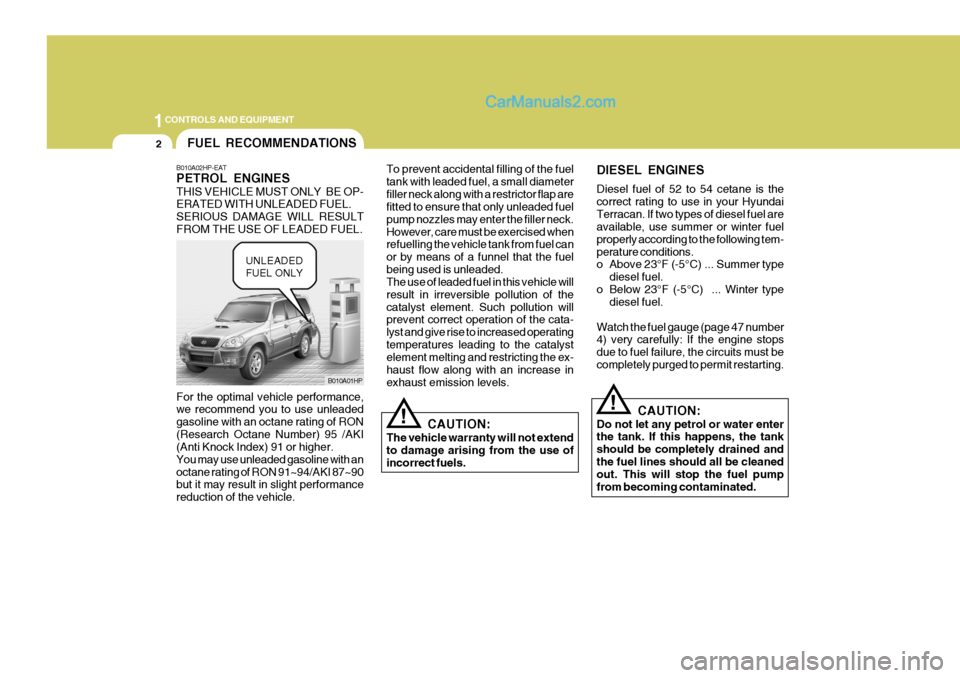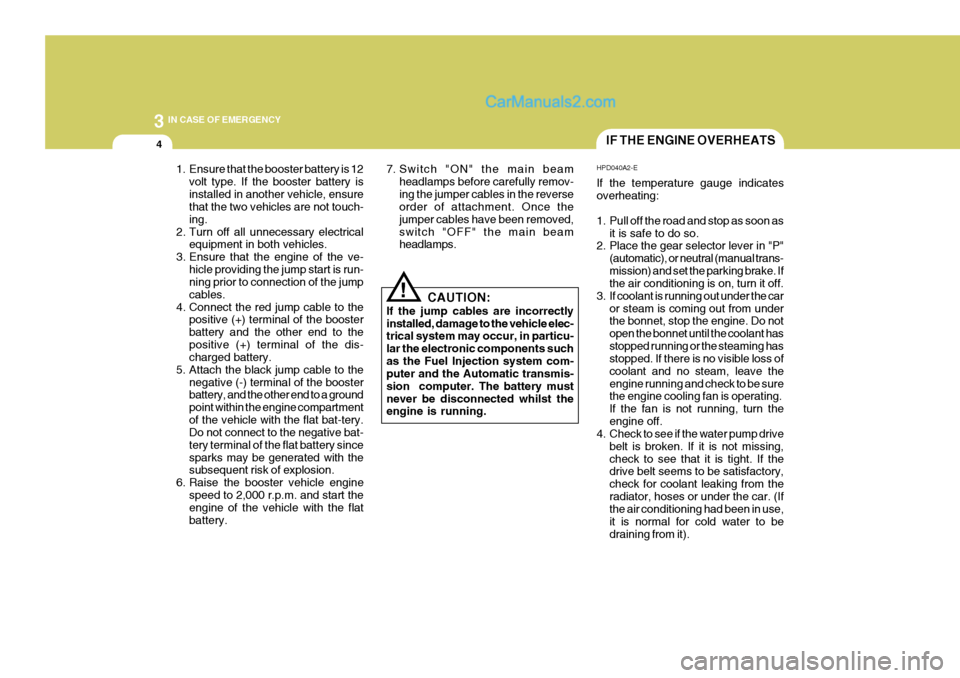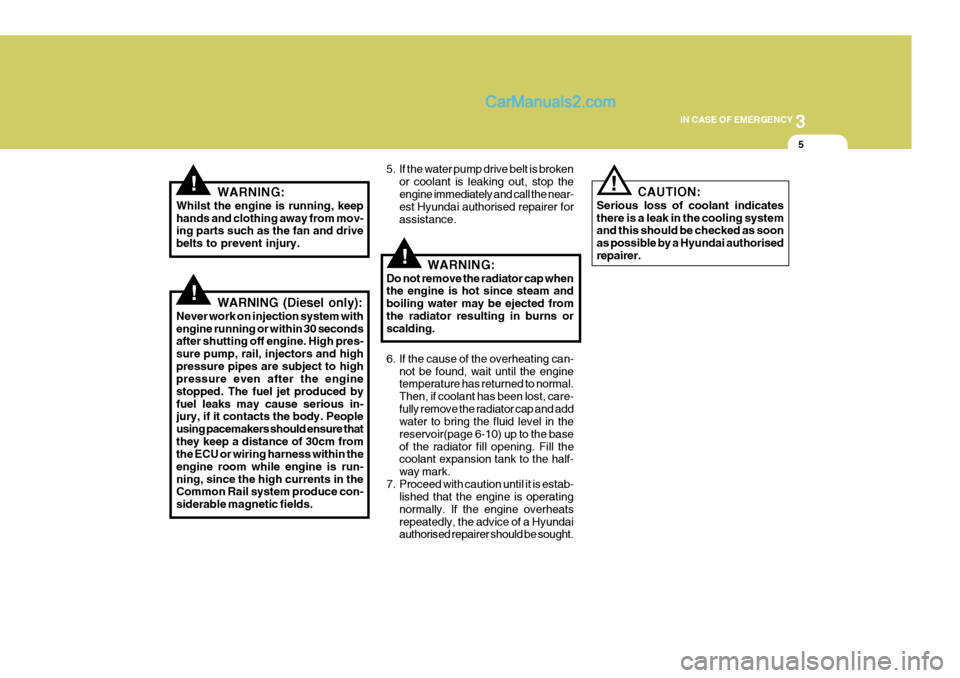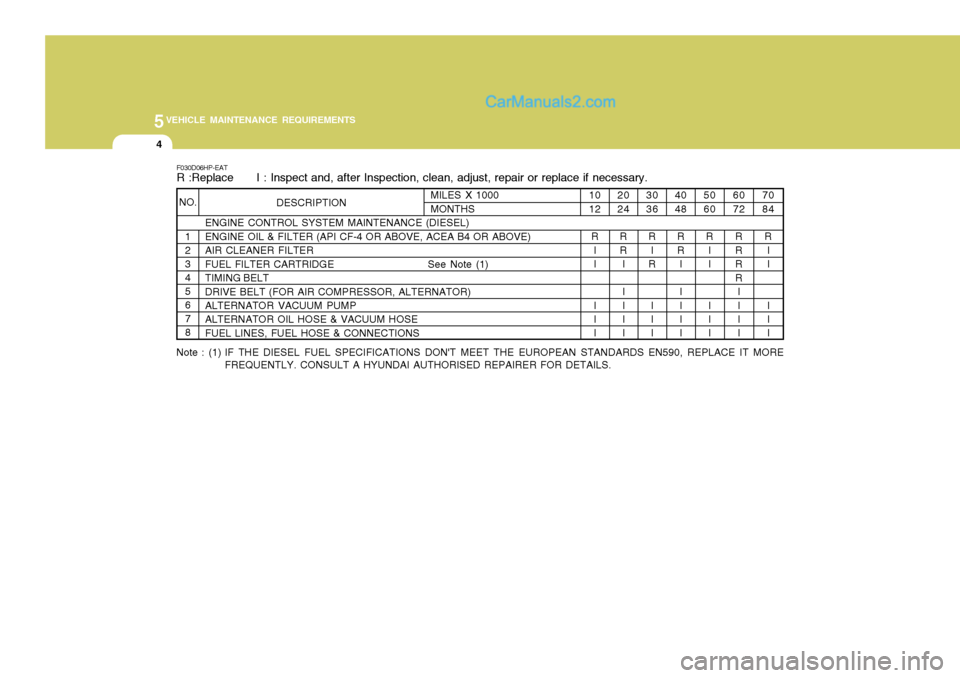2006 Hyundai Terracan fuel pump
[x] Cancel search: fuel pumpPage 310 of 539

1CONTROLS AND EQUIPMENT
2
CAUTION:
The vehicle warranty will not extend to damage arising from the use ofincorrect fuels.
To prevent accidental filling of the fueltank with leaded fuel, a small diameterfiller neck along with a restrictor flap are fitted to ensure that only unleaded fuel pump nozzles may enter the filler neck.However, care must be exercised when refuelling the vehicle tank from fuel can or by means of a funnel that the fuelbeing used is unleaded. The use of leaded fuel in this vehicle will result in irreversible pollution of thecatalyst element. Such pollution will prevent correct operation of the cata- lyst and give rise to increased operatingtemperatures leading to the catalyst element melting and restricting the ex- haust flow along with an increase inexhaust emission levels.
DIESEL ENGINES Diesel fuel of 52 to 54 cetane is the correct rating to use in your HyundaiTerracan. If two types of diesel fuel are available, use summer or winter fuel properly according to the following tem-perature conditions.
o Above 23°F (-5°C) ... Summer type
diesel fuel.
o Below 23°F (-5°C) ... Winter type diesel fuel.
Watch the fuel gauge (page 47 number4) very carefully: If the engine stops due to fuel failure, the circuits must becompletely purged to permit restarting.FUEL RECOMMENDATIONS
B010A02HP-EAT PETROL ENGINES THIS VEHICLE MUST ONLY BE OP- ERATED WITH UNLEADED FUEL. SERIOUS DAMAGE WILL RESULTFROM THE USE OF LEADED FUEL. For the optimal vehicle performance, we recommend you to use unleaded gasoline with an octane rating of RON(Research Octane Number) 95 /AKI (Anti Knock Index) 91 or higher. You may use unleaded gasoline with anoctane rating of RON 91~94/AKI 87~90 but it may result in slight performance reduction of the vehicle.
B010A01HP
!
!
UNLEADED FUEL ONLY
CAUTION:
Do not let any petrol or water enter the tank. If this happens, the tank should be completely drained andthe fuel lines should all be cleaned out. This will stop the fuel pump from becoming contaminated.
Page 360 of 539

1CONTROLS AND EQUIPMENT
52
SB2100I-EDoor Open (Ajar) Warn- ing Light
The door ajar warning light warns you that a door is not completely closed. Ensure that the light is extinguished prior to driving the vehicle. B260M01A-AAT Low Fuel Level Warning Light
The low fuel level warning light comes on when the fuel tank is approaching empty. When it comes on, you should add fuel as soon as possible. Drivingwith the fuel level warning light on or with the fuel level below "E" can cause the engine to misfire and damage thecatalytic converter.
B260A01B-GAT
Front Fog Indicator Light
Front fog indicator light comes on when-ever the fog light switch is on. B260K01B-EAT
Tailgate Door Open Warn- ing Light
This light remains on unless the tail-
gate door is completely closed andlatched. B260B01HP-EAT SRS (Airbag) Service Reminder Indicator (SRI)
The SRS service reminder indicator (SRI) comes on and flashes for approxi- mately 6 seconds after the ignition key is turned to the "ON" position or after the engine is started, after which it willgo out. This light also comes on when the SRS is not working properly. If the SRI does not flash, or continuously remains on after flashing for about 6 seconds whenyou turned the ignition key to the "ON" position or started the engine, or if it comes on whilst driving, have the SRSinspected by a Hyundai authorised re- pairer.
!
B260J01S-EAT
Charging System Warn- ing Light
CAUTION:
If the drive belt (generator belt) is loose, broken, or missing whilst thevehicle is driving, there may be a serious malfunction, the engine could also overheat because thisbelt also drives the water pump.
The charging system warning light should come on when the ignition is turned on, then go out when the engine is running. If the light stays on whilst theengine is running, there is a malfunction in the electrical charging system. If the light comes on whilst you are driving,stop, turn off the engine and check under the bonnet. First, make certain the generator drive belt is in place. If itis, check the tension of the belt. And then, have the system checked by your Hyundai authorised repairer.
Page 448 of 539

3 IN CASE OF EMERGENCY
2
!WARNING:
If the engine refuses to start, no attempt should be made to push or tow start the vehicle. Vehicles with automatic transmission or fuel in-jection will not be able to be started in this manner since no drive is transmitted through the automatictransmission whilst the engine is not running, and in the case of fuel injected derivatives, the fuel pumpwill not operate under tow start conditions. In addition, if the ve- hicle is equipped with an exhaustcatalyst, damage to the catalyst may result if the vehicle is tow started. HPD020B1-E If The Engine Cannot Be Cranked
1. If the vehicle is fitted with manual
transmission, ensure that the clutch pedal is depressed whilst cranking the engine. If the vehicle is fitted with automatic transmission, en-sure that the transmission selector is at the "P" or "N" position.
2. Check the battery terminals and
connections to ensure that theseare clean and also tight.
3. If the ignition warning lights dim
when the engine is cranked and thebattery terminals have been checked, a discharged battery isindicated. 4. Do not attempt to push or tow start
the vehicle, refer to "Jump Starting"for information regarding engine start- ing when the battery is discharged.
D010C02A-EAT If Engine Turns Over Normally but Does Not Start
1. Check fuel level.
2. With the key in the "OFF" position, check all connectors at ignition coilsand spark plugs(For Petrol Engine) or check all connectors at glow plugand glow plug relay(For Diesel En- gine). Reconnect any that may be disconnected or loose.
3. Check fuel line in the engine com- partment.
4. If engine still refuses to start, call a Hyundai authorised repairer or seek other qualified assistance.
IF THE ENGINE WILL NOT START
SD020A1-E Seek assistance from the nearest Hyundai authorised repairer with regard to the method of ignition and fuel sys- tem diagnosis.
HHP5020-E
Page 450 of 539

3 IN CASE OF EMERGENCY
4
!
1. Ensure that the booster battery is 12
volt type. If the booster battery is installed in another vehicle, ensure that the two vehicles are not touch- ing.
2. Turn off all unnecessary electrical equipment in both vehicles.
3. Ensure that the engine of the ve- hicle providing the jump start is run- ning prior to connection of the jump cables.
4. Connect the red jump cable to the positive (+) terminal of the boosterbattery and the other end to thepositive (+) terminal of the dis- charged battery.
5. Attach the black jump cable to the negative (-) terminal of the boosterbattery, and the other end to a ground point within the engine compartmentof the vehicle with the flat bat-tery. Do not connect to the negative bat- tery terminal of the flat battery sincesparks may be generated with the subsequent risk of explosion.
6. Raise the booster vehicle engine speed to 2,000 r.p.m. and start theengine of the vehicle with the flat battery. 7. Switch "ON" the main beam
headlamps before carefully remov-ing the jumper cables in the reverse order of attachment. Once the jumper cables have been removed,switch "OFF" the main beam headlamps.
CAUTION:
If the jump cables are incorrectly installed, damage to the vehicle elec- trical system may occur, in particu- lar the electronic components suchas the Fuel Injection system com- puter and the Automatic transmis- sion computer. The battery mustnever be disconnected whilst the engine is running.
IF THE ENGINE OVERHEATS
HPD040A2-E If the temperature gauge indicates overheating:
1. Pull off the road and stop as soon as it is safe to do so.
2. Place the gear selector lever in "P"
(automatic), or neutral (manual trans- mission) and set the parking brake. If the air conditioning is on, turn it off.
3. If coolant is running out under the car or steam is coming out from underthe bonnet, stop the engine. Do not open the bonnet until the coolant hasstopped running or the steaming has stopped. If there is no visible loss of coolant and no steam, leave theengine running and check to be sure the engine cooling fan is operating. If the fan is not running, turn theengine off.
4. Check to see if the water pump drive
belt is broken. If it is not missing,check to see that it is tight. If the drive belt seems to be satisfactory, check for coolant leaking from theradiator, hoses or under the car. (If the air conditioning had been in use, it is normal for cold water to bedraining from it).
Page 451 of 539

3
IN CASE OF EMERGENCY
5
!
!
!WARNING:
Whilst the engine is running, keep hands and clothing away from mov- ing parts such as the fan and drive belts to prevent injury.
WARNING (Diesel only):
Never work on injection system withengine running or within 30 seconds after shutting off engine. High pres- sure pump, rail, injectors and highpressure pipes are subject to high pressure even after the engine stopped. The fuel jet produced byfuel leaks may cause serious in- jury, if it contacts the body. People using pacemakers should ensure thatthey keep a distance of 30cm from the ECU or wiring harness within the engine room while engine is run-ning, since the high currents in the Common Rail system produce con- siderable magnetic fields. 5. If the water pump drive belt is broken
or coolant is leaking out, stop theengine immediately and call the near- est Hyundai authorised repairer for assistance.
WARNING:
Do not remove the radiator cap when the engine is hot since steam and boiling water may be ejected fromthe radiator resulting in burns or scalding.
6. If the cause of the overheating can- not be found, wait until the engine temperature has returned to normal. Then, if coolant has been lost, care-fully remove the radiator cap and add water to bring the fluid level in the reservoir(page 6-10) up to the baseof the radiator fill opening. Fill the coolant expansion tank to the half- way mark.
7. Proceed with caution until it is estab- lished that the engine is operatingnormally. If the engine overheatsrepeatedly, the advice of a Hyundai authorised repairer should be sought.! CAUTION:
Serious loss of coolant indicates there is a leak in the cooling system and this should be checked as soon as possible by a Hyundai authorisedrepairer.
Page 472 of 539

5VEHICLE MAINTENANCE REQUIREMENTS
4
NO.1 2345678 ENGINE CONTROL SYSTEM MAINTENANCE (DIESEL) ENGINE OIL & FILTER (API CF-4 OR ABOVE, ACEA B4 OR ABOVE)AIR CLEANER FILTER
FUEL FILTER CARTRIDGE See Note (1)TIMING BELTDRIVE BELT (FOR AIR COMPRESSOR, ALTERNATOR) ALTERNATOR VACUUM PUMP ALTERNATOR OIL HOSE & VACUUM HOSEFUEL LINES, FUEL HOSE & CONNECTIONS
F030D06HP-EAT R :Replace I : Inspect and, after Inspection, clean, adjust, repair or replace if necessary.
70 84
R II I I I
6072
RRRR II I I
5060
R II I I I
4048
RR I I I I I
3036
R I
R
I I I
2024
RR I I I I I
1012
R II I I I
MILES X 1000MONTHSDESCRIPTION
Note : (1) IF THE DIESEL FUEL SPECIFICATIONS DON'T MEET THE EUROPEAN STANDARDS EN590, REPLACE IT MORE
FREQUENTLY. CONSULT A HYUNDAI AUTHORISED REPAIRER FOR DETAILS.
Page 475 of 539

5
VEHICLE MAINTENANCE REQUIREMENTS
7
!
F060B01A-EAT
o Drive belts
Inspect all drive belts for evidence of cuts, cracks, excessive wear or oil contamination and replace if neces-sary. Drive belts should be checked periodically for proper tension and ad- justed as necessary. F060C01A-AAT
o Fuel filter
A clogged filter can limit the speed at
which the vehicle may be driven, dam- age the emission system and cause hard starting. If an excessive amountof foreign matter accumulates in the fuel tank, the filter may require re- placement more frequently. After installing a new filter, run the
engine for several minutes, and checkfor leaks at the connections. Fuel fil- ters should be installed by trained technicians.
F060D01TB-EAT
o Fuel lines, fuel hoses and con- nections
Check the fuel lines, fuel hoses and
connections for leakage and damage. Have a trained technician replace anydamaged or leaking parts immediately. WARNING (Diesel only):
Never work on injection system withengine running or within 30 sec-onds after shutting off engine. High pressure pump, rail, injectors and high pressure pipes are subject tohigh pressure even after the engine stopped. The fuel jet produced by fuel leaks may cause serious injury,if it contacts the body. People using pacemakers should ensure that they keep a distance of 30cm from theECU or wiring harness within the engine room while engine is run- ning, since the high currents in theCommon Rail system produce con- siderable magnetic fields.
EXPLANATION OF SCHED- ULED MAINTENANCE ITEMS
F060M01A-AAT
o Engine oil and filter
The engine oil and filter should be
changed at the intervals specified in the maintenance schedule. If the car is being driven in severe conditions,more frequent oil and filter changes are required.
Page 496 of 539

6 OWNER MAINTENANCE
18
!
!!WARNING (Diesel only):
Never work on injection system with
engine running or within 30 sec- onds after shutting off engine. Highpressure pump, rail, injectors and high pressure pipes are subject to high pressure even after the enginestopped. The fuel jet produced by fuel leaks may cause serious injury, if it contacts the body. People usingpacemakers should ensure that they keep a distance of 30cm from the ECU or wiring harness within theengine room whilst engine is run- ning, since the high currents in the Common Rail system produce con-siderable magnetic fields.
WARNING:
The electric engine cooling fan au-
tomatically switches on and off ac- cording to engine temperature. Be careful to keep away from the fanduring this check as it may switch on at any time.
NOTE: Only lint free cloth should be used
for wiping the dipstick. The pres- ence of lint within the transmis- sion may cause problems with the normal function of the transmis-sion. CAUTION:
Correct operation of the braking
system is essential to the safe op- eration of the vehicle and there- fore, any maintenance operationsother than those listed below should be entrusted to a Hyundai authorised repairer.
SG120C2-E
Brake Fluid Recommendations
Only brake fluid conforming to DOT 3
or DOT 4 specifications or highermay be used in the braking system. Care should be taken to observe the instructions and precautions printedupon the container.
BRAKE SYSTEM CHECKING
SG120A1-E